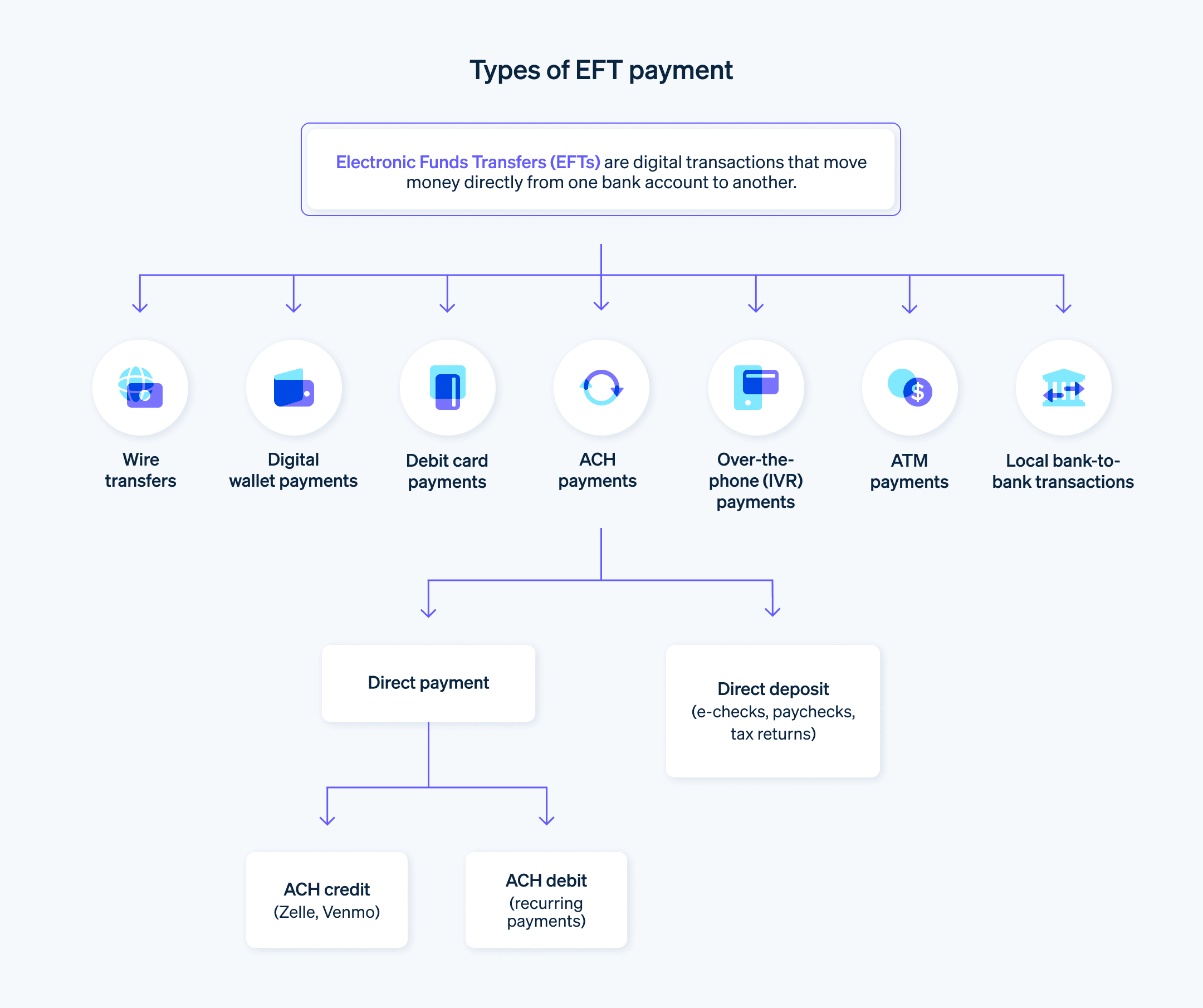De cartões de débito a caixas eletrônicos e wire transfers, as transferências eletrônicas se tornaram uma maneira segura e eficiente de enviar fundos, mas os vários tipos de transferências disponíveis podem dificultar a identificação do melhor método para o seu negócio. Por exemplo, qual é a diferença entre uma transferência eletrônica de fundos (EFT) e um pagamento Automated Clearing House (ACH)? E quando é melhor usar um ou outro?
Abordamos as diferenças e semelhanças entre EFTs e pagamentos ACH, para que finalidade cada tipo é usado e o que você deve saber sobre as formas de pagamento eletrônicas para sua empresa.
Neste artigo:
- O que é uma EFT?
- O que é um pagamento ACH?
- ACH vs. EFT: qual é a diferença?
O que é um EFT?
EFTs são transações que movimentam fundos eletronicamente entre diferentes instituições financeiras, contas bancárias ou pessoas físicas. Costumam ser chamados de transferências bancárias eletrônicas, cheques eletrônicos e pagamentos eletrônicos.
Tipos de EFTs:
- Transferências ACH
- Transferências bancárias
- Transações em caixa eletrônico (saques, depósitos e transferências)
- Transações com cartão de débito
- Pagamentos peer-to-peer

O que é um pagamento ACH?
Pagamentos ACH são transferências eletrônicas de fundos que usam a Automated Clearing House, uma rede financeira centralizada dos EUA que bancos e cooperativas de crédito usam para enviar e receber pagamentos eletrônicos e transferências de dinheiro. A rede ACH é operada e regida pela National Automated Clearing House Association (Nacha), uma organização independente de bancos, cooperativas de crédito e empresas de processamento de pagamentos.
Os pagamentos ACH são uma maneira altamente flexível de enviar e receber fundos para inúmeros usos. Em 2021, mais de 426 milhões de pagamentos, totalizando US$ 2 trilhões, foram feitos pela rede ACH, um aumento de quase 18% em relação a 2020.
Tipos de pagamentos ACH:
Depósito direto ACH
Referindo-se a qualquer tipo de transferência de uma entidade governamental ou empresa para um consumidor, um depósito direto ACH permite que os empregadores transfiram fundos de folha de pagamento diretamente para as contas bancárias de seus funcionários. De acordo com a Nacha, 93% dos trabalhadores dos EUA recebem seus contracheques por depósito direto ACH.
Outros tipos de depósitos diretos:
- Despesas reembolsadas pelo empregador
- Benefícios governamentais
- Restituições de impostos
- Pagamentos de anuidades
- Pagamentos de juros
Pagamentos diretos ACH
Os pagamentos diretos permitem que consumidores e empresas emitam pagamentos diretamente de suas contas bancárias. Esses pagamentos podem ser usados para qualquer coisa, desde o pagamento de contas até a compra de bens e serviços.
ACH e EFT: qual é a diferença?
Os termos "transferências ACH" e "EFT" não são intercambiáveis, mas estão fortemente relacionados. As transferências ACH são um tipo de EFT, e as EFTs incluem transferências ACH, mas não se limitam a elas.
Existem diferenças adicionais entre os pagamentos ACH e outros tipos de EFTs:
Como são processados
Enquanto wire transfers são processadas individualmente em tempo real, as transferências ACH são liquidadas em lotes. Toda solicitação de transferência que entra na rede ACH ingressa em uma fila. Várias vezes, durante dias úteis, as transferências nessa fila são processadas em conjunto.Velocidade de transferência
Algumas EFTs, como carteiras digitais, transações em caixa eletrônico e pagamentos com cartão de débito, são autorizados e concluídos em alguns segundos. As wire transfers costumam levar de algumas horas a dois dias úteis. Os pagamentos ACH geralmente são considerados mais demorados do que wire transfers, mas as atualizações das regras operacionais da Nacha nos últimos anos expandiram consideravelmente o acesso a transferências ACH no mesmo dia.Custo
Os custos e taxas das EFTs variam consideravelmente, dependendo do tipo, da origem, do destino da transferência e do montante em dinheiro. Transações em caixa eletrônico e pagamentos enviados usando aplicativos ponto a ponto geralmente incorrem tarifas por transação de apenas alguns dólares, enquanto wire transfers internacionais podem custar até US$ 50 por transferência. Algumas transferências ACH são gratuitas e outras custam alguns dólares.
As diferenças entre os tipos de EFTs refletem a ampla gama de produtos e serviços que se enquadra neste termo. Compreendendo as várias opções disponíveis para transferir fundos, você pode tomar decisões inteligentes e práticas sobre qual tipo de EFT é o veículo ideal para atender às suas necessidades de pagamento.

O conteúdo deste artigo é apenas para fins gerais de informação e educação e não deve ser interpretado como aconselhamento jurídico ou tributário. A Stripe não garante a exatidão, integridade, adequação ou atualidade das informações contidas no artigo. Você deve procurar a ajuda de um advogado competente ou contador licenciado para atuar em sua jurisdição para aconselhamento sobre sua situação particular.